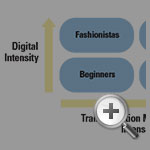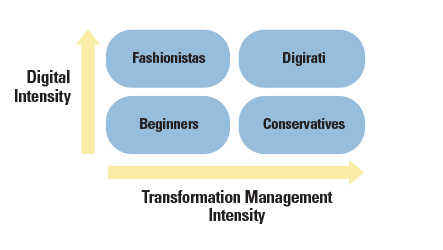The Advantages of Digital Maturity
The higher a company’s level of digital maturity, the better its financial performance is likely to be.
Topics
New digital technologies like social media, mobile and analytics are advancing rapidly on the economic landscape. These innovations are used widely by consumers and employees alike. Facebook alone has more than one billion users, and there are more than six billion mobile phones. What do traditional businesses do when employees have better digital solutions at home than they do at work, and customers are more technology savvy than the people trying to sell to them?
Executives in every industry — from media to electronics to paint manufacturing — face a bewildering array of new digital opportunities. These executives are paying attention, but they have few signposts to guide them. Most stories in the business media focus on fast-moving startups like Zynga and Pinterest, or on a few large high-tech companies like Apple, Google or Amazon. Unfortunately, to many leaders, stories of these nimble and innovative firms just do not make sense for traditional companies that are older, larger and burdened with inflexible legacies.
In phase two of our research on digital transformation for large businesses, the MIT Center for Digital Business and Capgemini Consulting studied nearly 400 large companies for two years. We found they are using technologies like social media, mobile analytics and embedded devices to change their customer engagement, internal operations and even their business models. But few firms have positioned themselves to capture the real business benefits. Our research points to a real “digital advantage” to those that do.
We’ve developed a digital maturity model to show how different companies are reacting to technological opportunity.
Digital maturity combines two separate but related things. One is digital intensity, the level of investment in technology-enabled initiatives meant to change how the company operates. The other is transformation management intensity, the level of investment in the leadership capabilities needed to create digital transformation within an organization.
Transformation intensity consists of the vision to shape a new future, governance and engagement to steer the course and IT/business relationships to implement technology-based change.
The Four Levels of Digital Maturity
Companies can have four levels of digital maturity: high digital and transformation management intensity, low digital and transformation management intensity, or a mix of the two. (See “Four Types of Digital Maturity.”)
Companies in the lower left are Digital Beginners. These businesses do very little with advanced digital capabilities, although they may be mature with more traditional applications such as ERP or electronic commerce. Although companies may be Digital Beginners by choice, more often than not they are in this quadrant by accident. They may be unaware of the opportunities, or may be starting some small investments without effective transformation management in place.
Organizations in the top left are Digital Fashionistas. These companies have implemented or experimented with many sexy digital applications. Some of these initiatives may create value, but many do not. While they may look good together, these digital applications are not implemented with the vision of gaining synergies among the items. Digital Fashionistas are motivated to bring on digitally powered change, but their digital transformation strategy is not founded on real knowledge of how to maximize business benefits. Companies lacking enterprise-level governance may find they are in this quadrant at the corporate level, even if digital efforts are more mature in some business units.
Companies in the bottom right are Digital Conservatives. They favor prudence over innovation. Digital Conservatives understand the need for a strong unifying vision as well as for governance and corporate culture to ensure investments are managed well. However, they are typically skeptical of the value of new digital trends, sometimes to their detriment. Though aiming to spend wisely, their careful approach may cause them to miss valuable opportunities upon which their more stylish competitors will pounce.
Businesses in the top right quadrant are Digirati. They truly understand how to drive value with digital transformation. They combine a transformative vision, careful governance and engagement, with sufficient investment in new opportunities. Through vision and engagement, they develop a digital culture that can envision further changes and implement them wisely. By investing and carefully coordinating digital initiatives, they continuously advance their digital competitive advantage.
Companies take different paths to digital maturity. Nike started by developing digital intensity in silos. Then it added elements of transformation management intensity to link the silos and launch new capabilities. Indian paint manufacturer Asian Paints went the other way, creating vision, governance and IT capabilities to become a more unified company. Then it repeatedly built on its capabilities to transform its customer engagement, internal operations and business models. Both companies are reaping huge benefits.
The Financial Advantage of Digital Maturity
These companies are not alone. The 391 companies in our survey vary widely on digital maturity. To understand the relationships between digital maturity and financial performance, we analyzed industry-adjusted financial performance of the 184 publicly traded firms on our sample. Comparing digitally mature companies to their less-mature competitors, we found striking differences. Companies that are mature in either of the two dimensions outstrip industry competitors along different dimensions of financial performance.
Digirati — those companies that are mature in both dimensions — have the highest performance as a group, far outperforming less-mature firms on multiple financial measures.
Companies that are mature on the digital intensity dimension (the vertical axis in the matrix) are better at driving revenue through their existing assets. On a basket of measures including revenue per employee and fixed asset turnover, the Digital Fashionista and Digirati groups outperform average industry performance by 6-9%.
Digital intensity helps companies to gain and manage more volume with existing physical capacity. The difference is substantial. For example, Digital Fashionistas — strong on digital intensity but not on transformation management intensity — drive 16% more revenues through their human and physical assets than Digital Conservatives do.
Moving in the other dimension, companies that are mature in transformation management intensity tend to be more profitable. On average, Digital Conservatives and Digirati are 9% to 26% more profitable than their average industry competitors on a basket of measures, including EBIT margin and net profit margin. For these companies, strong vision and governance help to align investments along a common direction. They weed out activities that run counter to the future vision of the transformed business. Then they engage their employees in identifying new opportunities.
In Summary
Every industry, regardless of how digitally mature, includes companies that are Digirati. In other words, every industry — from manufacturing to high technology — has businesses that have already begun to gain the benefits of digital transformation.
This should be a call to action for executives in every company. It takes several years to build maturity, especially in the transformation management intensity dimension. Digital Beginners in any industry are several years from gaining the digital maturity that their Digirati competitors already possess.



Comments (8)
5 good points to start with the right foot in Digital Marketing - Be More Digital
Digitale Transformation: entscheidend für die Zukunft jedes Unternehmens › Digicomp
It’s good but it’s not a digital transformation – The Business Leader
Digital maturity starts at the top – The Business Leader
Will CDO Steal CIO’s Leadership Role?
Les entreprises surévaluent-elles leur maturité numérique ? | Le Blog de Claude Super | Let's make your business more social!
siswanto.gatot549
anu2shree